Analyzing Gender Fluidity and Stereotypes in Shop Window Displays
VerifiedAdded on 2023/06/11
|8
|1818
|220
Essay
AI Summary
This essay delves into the ethical implications of gender stereotyping in shop window displays, focusing on Marks and Spencer as a case study. It examines how advertising practices, influenced by gender identity and social constructs, can perpetuate harmful stereotypes. The essay applies Judith Butler's gender performance theory to analyze how shop window displays reinforce rigid gender roles, limiting gender fluidity and freedom of expression. It investigates the cyclical interaction between advertisers and consumers, highlighting the need for improved gender fluidity in advertising to mitigate the negative impacts of gender stereotypes and promote inclusivity. The essay concludes that current shop window display advertising heavily relies on conventional gender divisions, hindering genuine gender fluidity and emphasizing the importance of ethical considerations in advertising practices.
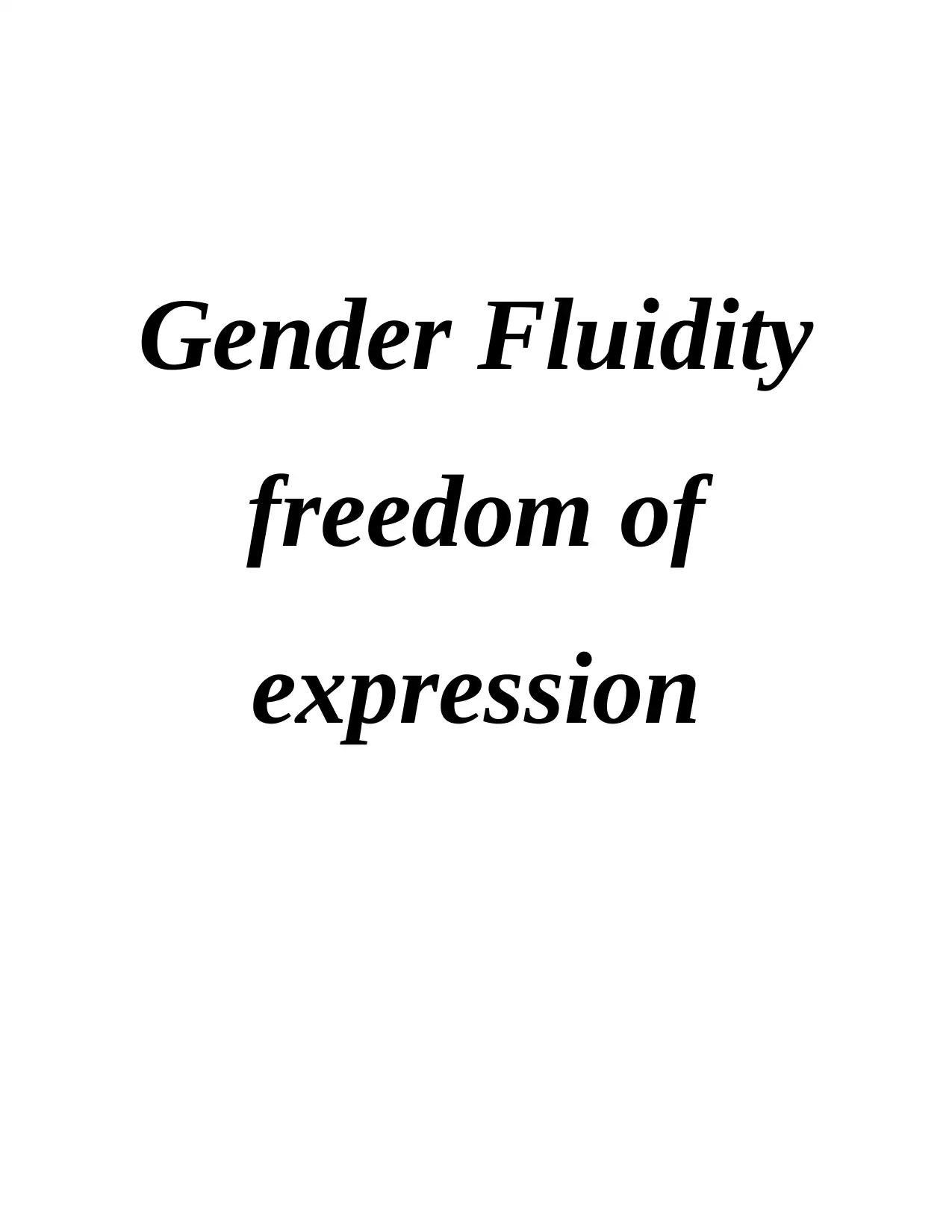
Gender Fluidity
freedom of
expression
freedom of
expression
Paraphrase This Document
Need a fresh take? Get an instant paraphrase of this document with our AI Paraphraser
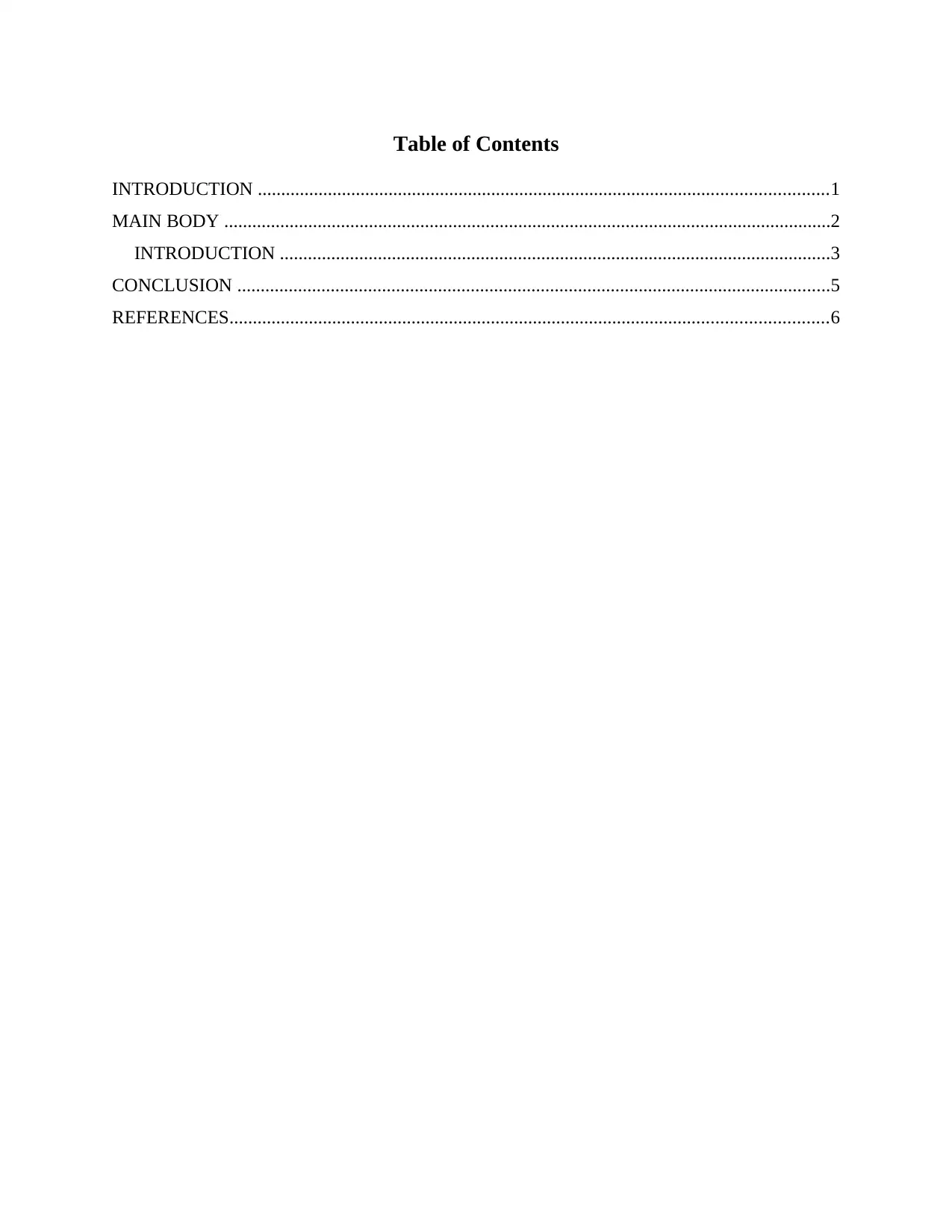
Table of Contents
INTRODUCTION ..........................................................................................................................1
MAIN BODY ..................................................................................................................................2
INTRODUCTION ......................................................................................................................3
CONCLUSION ...............................................................................................................................5
REFERENCES................................................................................................................................6
INTRODUCTION ..........................................................................................................................1
MAIN BODY ..................................................................................................................................2
INTRODUCTION ......................................................................................................................3
CONCLUSION ...............................................................................................................................5
REFERENCES................................................................................................................................6
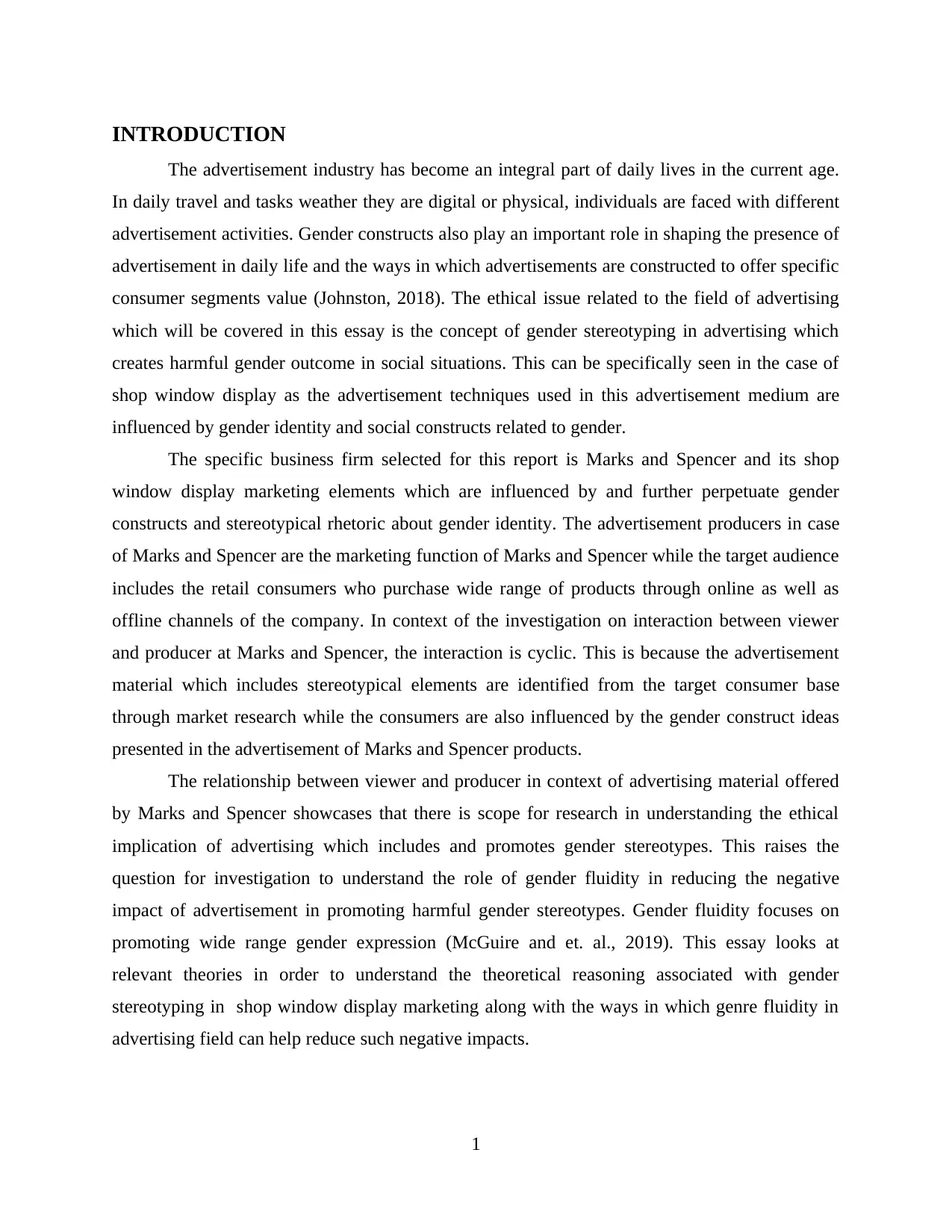
INTRODUCTION
The advertisement industry has become an integral part of daily lives in the current age.
In daily travel and tasks weather they are digital or physical, individuals are faced with different
advertisement activities. Gender constructs also play an important role in shaping the presence of
advertisement in daily life and the ways in which advertisements are constructed to offer specific
consumer segments value (Johnston, 2018). The ethical issue related to the field of advertising
which will be covered in this essay is the concept of gender stereotyping in advertising which
creates harmful gender outcome in social situations. This can be specifically seen in the case of
shop window display as the advertisement techniques used in this advertisement medium are
influenced by gender identity and social constructs related to gender.
The specific business firm selected for this report is Marks and Spencer and its shop
window display marketing elements which are influenced by and further perpetuate gender
constructs and stereotypical rhetoric about gender identity. The advertisement producers in case
of Marks and Spencer are the marketing function of Marks and Spencer while the target audience
includes the retail consumers who purchase wide range of products through online as well as
offline channels of the company. In context of the investigation on interaction between viewer
and producer at Marks and Spencer, the interaction is cyclic. This is because the advertisement
material which includes stereotypical elements are identified from the target consumer base
through market research while the consumers are also influenced by the gender construct ideas
presented in the advertisement of Marks and Spencer products.
The relationship between viewer and producer in context of advertising material offered
by Marks and Spencer showcases that there is scope for research in understanding the ethical
implication of advertising which includes and promotes gender stereotypes. This raises the
question for investigation to understand the role of gender fluidity in reducing the negative
impact of advertisement in promoting harmful gender stereotypes. Gender fluidity focuses on
promoting wide range gender expression (McGuire and et. al., 2019). This essay looks at
relevant theories in order to understand the theoretical reasoning associated with gender
stereotyping in shop window display marketing along with the ways in which genre fluidity in
advertising field can help reduce such negative impacts.
1
The advertisement industry has become an integral part of daily lives in the current age.
In daily travel and tasks weather they are digital or physical, individuals are faced with different
advertisement activities. Gender constructs also play an important role in shaping the presence of
advertisement in daily life and the ways in which advertisements are constructed to offer specific
consumer segments value (Johnston, 2018). The ethical issue related to the field of advertising
which will be covered in this essay is the concept of gender stereotyping in advertising which
creates harmful gender outcome in social situations. This can be specifically seen in the case of
shop window display as the advertisement techniques used in this advertisement medium are
influenced by gender identity and social constructs related to gender.
The specific business firm selected for this report is Marks and Spencer and its shop
window display marketing elements which are influenced by and further perpetuate gender
constructs and stereotypical rhetoric about gender identity. The advertisement producers in case
of Marks and Spencer are the marketing function of Marks and Spencer while the target audience
includes the retail consumers who purchase wide range of products through online as well as
offline channels of the company. In context of the investigation on interaction between viewer
and producer at Marks and Spencer, the interaction is cyclic. This is because the advertisement
material which includes stereotypical elements are identified from the target consumer base
through market research while the consumers are also influenced by the gender construct ideas
presented in the advertisement of Marks and Spencer products.
The relationship between viewer and producer in context of advertising material offered
by Marks and Spencer showcases that there is scope for research in understanding the ethical
implication of advertising which includes and promotes gender stereotypes. This raises the
question for investigation to understand the role of gender fluidity in reducing the negative
impact of advertisement in promoting harmful gender stereotypes. Gender fluidity focuses on
promoting wide range gender expression (McGuire and et. al., 2019). This essay looks at
relevant theories in order to understand the theoretical reasoning associated with gender
stereotyping in shop window display marketing along with the ways in which genre fluidity in
advertising field can help reduce such negative impacts.
1
⊘ This is a preview!⊘
Do you want full access?
Subscribe today to unlock all pages.

Trusted by 1+ million students worldwide
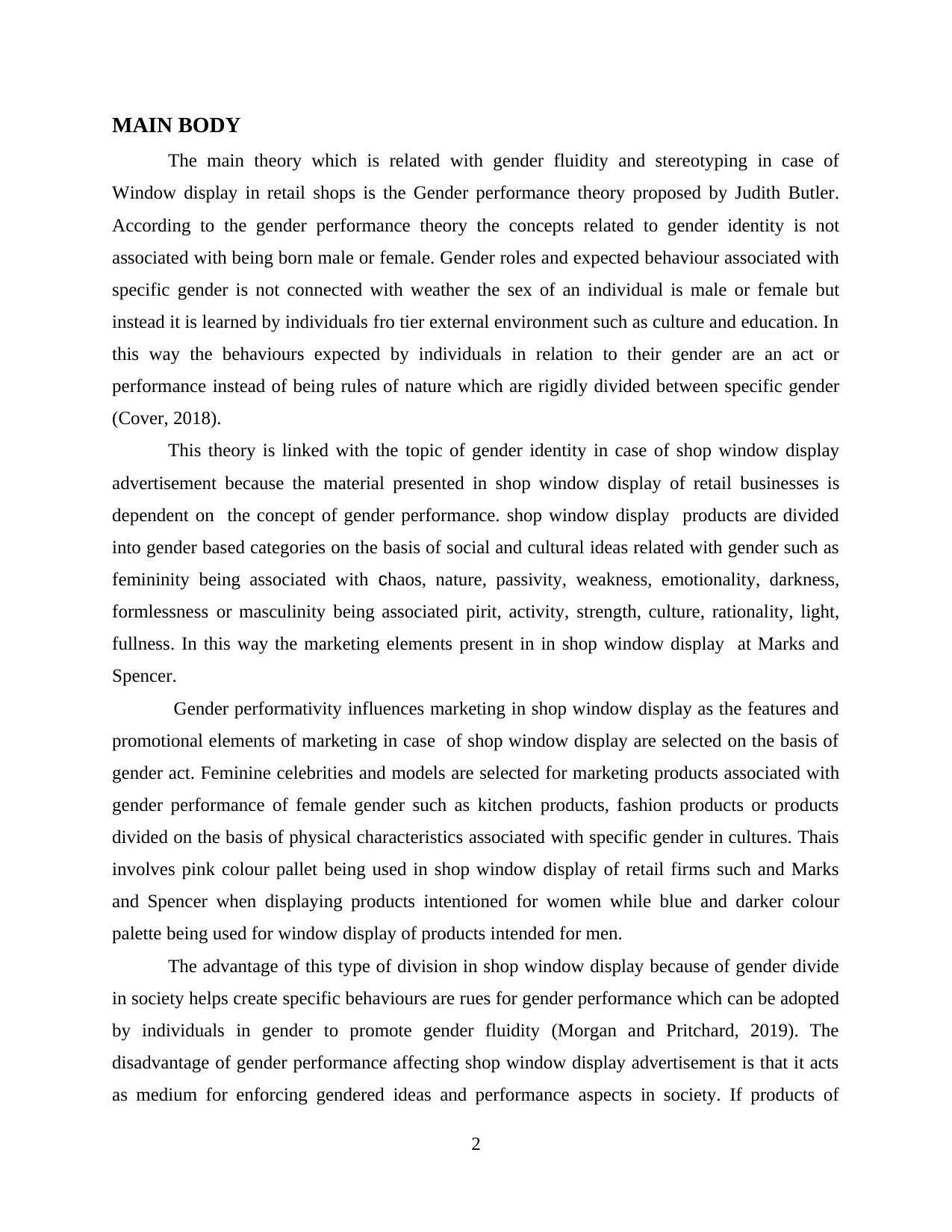
MAIN BODY
The main theory which is related with gender fluidity and stereotyping in case of
Window display in retail shops is the Gender performance theory proposed by Judith Butler.
According to the gender performance theory the concepts related to gender identity is not
associated with being born male or female. Gender roles and expected behaviour associated with
specific gender is not connected with weather the sex of an individual is male or female but
instead it is learned by individuals fro tier external environment such as culture and education. In
this way the behaviours expected by individuals in relation to their gender are an act or
performance instead of being rules of nature which are rigidly divided between specific gender
(Cover, 2018).
This theory is linked with the topic of gender identity in case of shop window display
advertisement because the material presented in shop window display of retail businesses is
dependent on the concept of gender performance. shop window display products are divided
into gender based categories on the basis of social and cultural ideas related with gender such as
femininity being associated with chaos, nature, passivity, weakness, emotionality, darkness,
formlessness or masculinity being associated pirit, activity, strength, culture, rationality, light,
fullness. In this way the marketing elements present in in shop window display at Marks and
Spencer.
Gender performativity influences marketing in shop window display as the features and
promotional elements of marketing in case of shop window display are selected on the basis of
gender act. Feminine celebrities and models are selected for marketing products associated with
gender performance of female gender such as kitchen products, fashion products or products
divided on the basis of physical characteristics associated with specific gender in cultures. Thais
involves pink colour pallet being used in shop window display of retail firms such and Marks
and Spencer when displaying products intentioned for women while blue and darker colour
palette being used for window display of products intended for men.
The advantage of this type of division in shop window display because of gender divide
in society helps create specific behaviours are rues for gender performance which can be adopted
by individuals in gender to promote gender fluidity (Morgan and Pritchard, 2019). The
disadvantage of gender performance affecting shop window display advertisement is that it acts
as medium for enforcing gendered ideas and performance aspects in society. If products of
2
The main theory which is related with gender fluidity and stereotyping in case of
Window display in retail shops is the Gender performance theory proposed by Judith Butler.
According to the gender performance theory the concepts related to gender identity is not
associated with being born male or female. Gender roles and expected behaviour associated with
specific gender is not connected with weather the sex of an individual is male or female but
instead it is learned by individuals fro tier external environment such as culture and education. In
this way the behaviours expected by individuals in relation to their gender are an act or
performance instead of being rules of nature which are rigidly divided between specific gender
(Cover, 2018).
This theory is linked with the topic of gender identity in case of shop window display
advertisement because the material presented in shop window display of retail businesses is
dependent on the concept of gender performance. shop window display products are divided
into gender based categories on the basis of social and cultural ideas related with gender such as
femininity being associated with chaos, nature, passivity, weakness, emotionality, darkness,
formlessness or masculinity being associated pirit, activity, strength, culture, rationality, light,
fullness. In this way the marketing elements present in in shop window display at Marks and
Spencer.
Gender performativity influences marketing in shop window display as the features and
promotional elements of marketing in case of shop window display are selected on the basis of
gender act. Feminine celebrities and models are selected for marketing products associated with
gender performance of female gender such as kitchen products, fashion products or products
divided on the basis of physical characteristics associated with specific gender in cultures. Thais
involves pink colour pallet being used in shop window display of retail firms such and Marks
and Spencer when displaying products intentioned for women while blue and darker colour
palette being used for window display of products intended for men.
The advantage of this type of division in shop window display because of gender divide
in society helps create specific behaviours are rues for gender performance which can be adopted
by individuals in gender to promote gender fluidity (Morgan and Pritchard, 2019). The
disadvantage of gender performance affecting shop window display advertisement is that it acts
as medium for enforcing gendered ideas and performance aspects in society. If products of
2
Paraphrase This Document
Need a fresh take? Get an instant paraphrase of this document with our AI Paraphraser
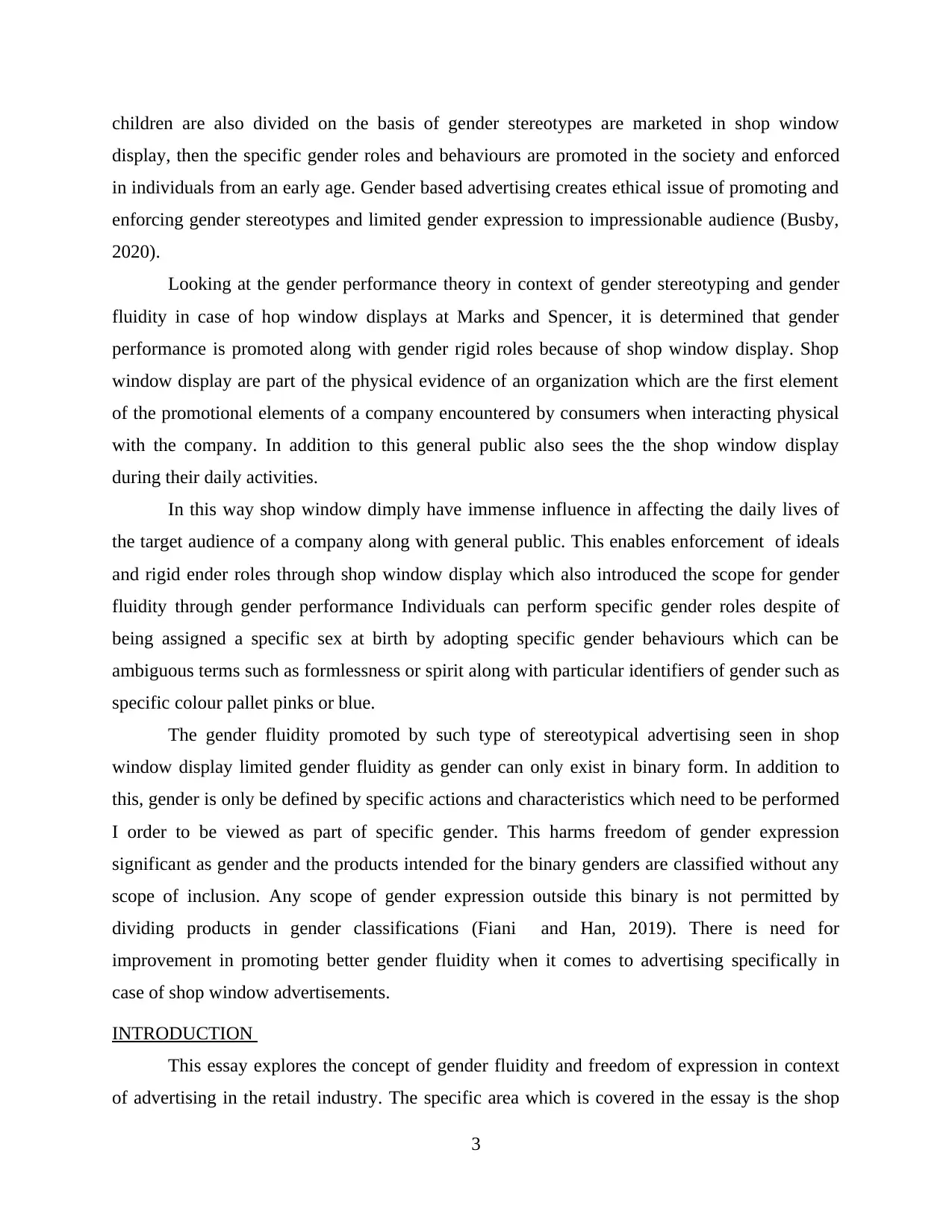
children are also divided on the basis of gender stereotypes are marketed in shop window
display, then the specific gender roles and behaviours are promoted in the society and enforced
in individuals from an early age. Gender based advertising creates ethical issue of promoting and
enforcing gender stereotypes and limited gender expression to impressionable audience (Busby,
2020).
Looking at the gender performance theory in context of gender stereotyping and gender
fluidity in case of hop window displays at Marks and Spencer, it is determined that gender
performance is promoted along with gender rigid roles because of shop window display. Shop
window display are part of the physical evidence of an organization which are the first element
of the promotional elements of a company encountered by consumers when interacting physical
with the company. In addition to this general public also sees the the shop window display
during their daily activities.
In this way shop window dimply have immense influence in affecting the daily lives of
the target audience of a company along with general public. This enables enforcement of ideals
and rigid ender roles through shop window display which also introduced the scope for gender
fluidity through gender performance Individuals can perform specific gender roles despite of
being assigned a specific sex at birth by adopting specific gender behaviours which can be
ambiguous terms such as formlessness or spirit along with particular identifiers of gender such as
specific colour pallet pinks or blue.
The gender fluidity promoted by such type of stereotypical advertising seen in shop
window display limited gender fluidity as gender can only exist in binary form. In addition to
this, gender is only be defined by specific actions and characteristics which need to be performed
I order to be viewed as part of specific gender. This harms freedom of gender expression
significant as gender and the products intended for the binary genders are classified without any
scope of inclusion. Any scope of gender expression outside this binary is not permitted by
dividing products in gender classifications (Fiani and Han, 2019). There is need for
improvement in promoting better gender fluidity when it comes to advertising specifically in
case of shop window advertisements.
INTRODUCTION
This essay explores the concept of gender fluidity and freedom of expression in context
of advertising in the retail industry. The specific area which is covered in the essay is the shop
3
display, then the specific gender roles and behaviours are promoted in the society and enforced
in individuals from an early age. Gender based advertising creates ethical issue of promoting and
enforcing gender stereotypes and limited gender expression to impressionable audience (Busby,
2020).
Looking at the gender performance theory in context of gender stereotyping and gender
fluidity in case of hop window displays at Marks and Spencer, it is determined that gender
performance is promoted along with gender rigid roles because of shop window display. Shop
window display are part of the physical evidence of an organization which are the first element
of the promotional elements of a company encountered by consumers when interacting physical
with the company. In addition to this general public also sees the the shop window display
during their daily activities.
In this way shop window dimply have immense influence in affecting the daily lives of
the target audience of a company along with general public. This enables enforcement of ideals
and rigid ender roles through shop window display which also introduced the scope for gender
fluidity through gender performance Individuals can perform specific gender roles despite of
being assigned a specific sex at birth by adopting specific gender behaviours which can be
ambiguous terms such as formlessness or spirit along with particular identifiers of gender such as
specific colour pallet pinks or blue.
The gender fluidity promoted by such type of stereotypical advertising seen in shop
window display limited gender fluidity as gender can only exist in binary form. In addition to
this, gender is only be defined by specific actions and characteristics which need to be performed
I order to be viewed as part of specific gender. This harms freedom of gender expression
significant as gender and the products intended for the binary genders are classified without any
scope of inclusion. Any scope of gender expression outside this binary is not permitted by
dividing products in gender classifications (Fiani and Han, 2019). There is need for
improvement in promoting better gender fluidity when it comes to advertising specifically in
case of shop window advertisements.
INTRODUCTION
This essay explores the concept of gender fluidity and freedom of expression in context
of advertising in the retail industry. The specific area which is covered in the essay is the shop
3
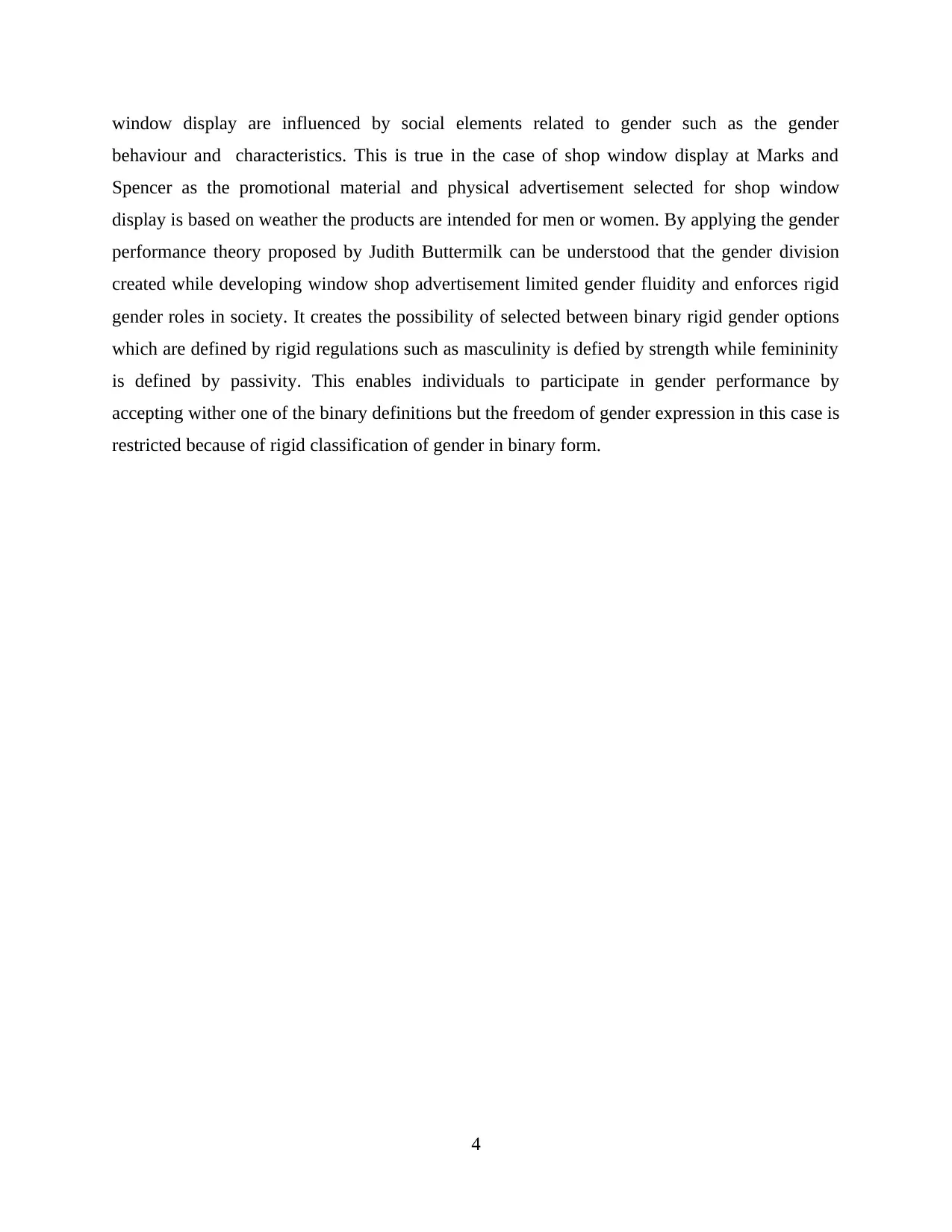
window display are influenced by social elements related to gender such as the gender
behaviour and characteristics. This is true in the case of shop window display at Marks and
Spencer as the promotional material and physical advertisement selected for shop window
display is based on weather the products are intended for men or women. By applying the gender
performance theory proposed by Judith Buttermilk can be understood that the gender division
created while developing window shop advertisement limited gender fluidity and enforces rigid
gender roles in society. It creates the possibility of selected between binary rigid gender options
which are defined by rigid regulations such as masculinity is defied by strength while femininity
is defined by passivity. This enables individuals to participate in gender performance by
accepting wither one of the binary definitions but the freedom of gender expression in this case is
restricted because of rigid classification of gender in binary form.
4
behaviour and characteristics. This is true in the case of shop window display at Marks and
Spencer as the promotional material and physical advertisement selected for shop window
display is based on weather the products are intended for men or women. By applying the gender
performance theory proposed by Judith Buttermilk can be understood that the gender division
created while developing window shop advertisement limited gender fluidity and enforces rigid
gender roles in society. It creates the possibility of selected between binary rigid gender options
which are defined by rigid regulations such as masculinity is defied by strength while femininity
is defined by passivity. This enables individuals to participate in gender performance by
accepting wither one of the binary definitions but the freedom of gender expression in this case is
restricted because of rigid classification of gender in binary form.
4
⊘ This is a preview!⊘
Do you want full access?
Subscribe today to unlock all pages.

Trusted by 1+ million students worldwide
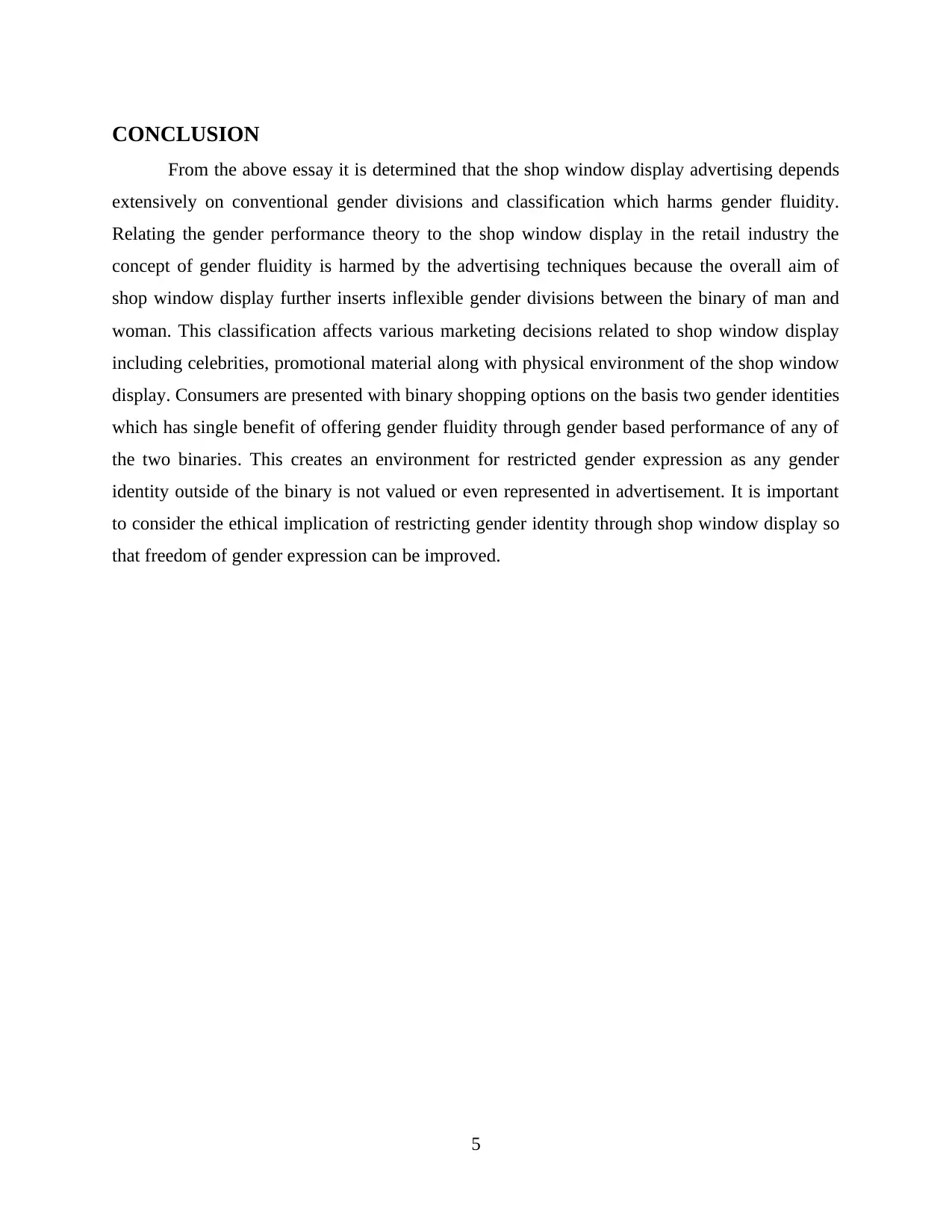
CONCLUSION
From the above essay it is determined that the shop window display advertising depends
extensively on conventional gender divisions and classification which harms gender fluidity.
Relating the gender performance theory to the shop window display in the retail industry the
concept of gender fluidity is harmed by the advertising techniques because the overall aim of
shop window display further inserts inflexible gender divisions between the binary of man and
woman. This classification affects various marketing decisions related to shop window display
including celebrities, promotional material along with physical environment of the shop window
display. Consumers are presented with binary shopping options on the basis two gender identities
which has single benefit of offering gender fluidity through gender based performance of any of
the two binaries. This creates an environment for restricted gender expression as any gender
identity outside of the binary is not valued or even represented in advertisement. It is important
to consider the ethical implication of restricting gender identity through shop window display so
that freedom of gender expression can be improved.
5
From the above essay it is determined that the shop window display advertising depends
extensively on conventional gender divisions and classification which harms gender fluidity.
Relating the gender performance theory to the shop window display in the retail industry the
concept of gender fluidity is harmed by the advertising techniques because the overall aim of
shop window display further inserts inflexible gender divisions between the binary of man and
woman. This classification affects various marketing decisions related to shop window display
including celebrities, promotional material along with physical environment of the shop window
display. Consumers are presented with binary shopping options on the basis two gender identities
which has single benefit of offering gender fluidity through gender based performance of any of
the two binaries. This creates an environment for restricted gender expression as any gender
identity outside of the binary is not valued or even represented in advertisement. It is important
to consider the ethical implication of restricting gender identity through shop window display so
that freedom of gender expression can be improved.
5
Paraphrase This Document
Need a fresh take? Get an instant paraphrase of this document with our AI Paraphraser
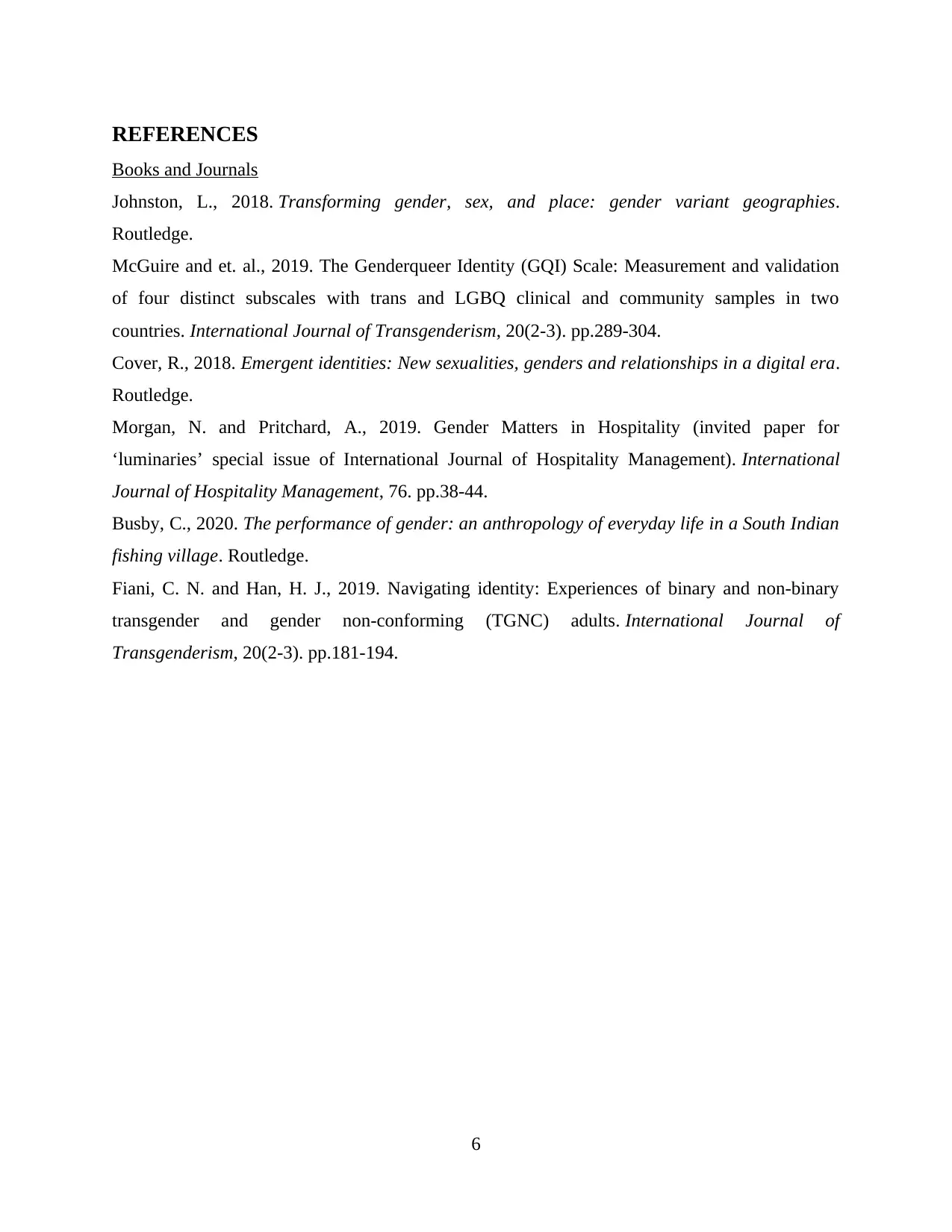
REFERENCES
Books and Journals
Johnston, L., 2018. Transforming gender, sex, and place: gender variant geographies.
Routledge.
McGuire and et. al., 2019. The Genderqueer Identity (GQI) Scale: Measurement and validation
of four distinct subscales with trans and LGBQ clinical and community samples in two
countries. International Journal of Transgenderism, 20(2-3). pp.289-304.
Cover, R., 2018. Emergent identities: New sexualities, genders and relationships in a digital era.
Routledge.
Morgan, N. and Pritchard, A., 2019. Gender Matters in Hospitality (invited paper for
‘luminaries’ special issue of International Journal of Hospitality Management). International
Journal of Hospitality Management, 76. pp.38-44.
Busby, C., 2020. The performance of gender: an anthropology of everyday life in a South Indian
fishing village. Routledge.
Fiani, C. N. and Han, H. J., 2019. Navigating identity: Experiences of binary and non-binary
transgender and gender non-conforming (TGNC) adults. International Journal of
Transgenderism, 20(2-3). pp.181-194.
6
Books and Journals
Johnston, L., 2018. Transforming gender, sex, and place: gender variant geographies.
Routledge.
McGuire and et. al., 2019. The Genderqueer Identity (GQI) Scale: Measurement and validation
of four distinct subscales with trans and LGBQ clinical and community samples in two
countries. International Journal of Transgenderism, 20(2-3). pp.289-304.
Cover, R., 2018. Emergent identities: New sexualities, genders and relationships in a digital era.
Routledge.
Morgan, N. and Pritchard, A., 2019. Gender Matters in Hospitality (invited paper for
‘luminaries’ special issue of International Journal of Hospitality Management). International
Journal of Hospitality Management, 76. pp.38-44.
Busby, C., 2020. The performance of gender: an anthropology of everyday life in a South Indian
fishing village. Routledge.
Fiani, C. N. and Han, H. J., 2019. Navigating identity: Experiences of binary and non-binary
transgender and gender non-conforming (TGNC) adults. International Journal of
Transgenderism, 20(2-3). pp.181-194.
6
1 out of 8
Your All-in-One AI-Powered Toolkit for Academic Success.
+13062052269
info@desklib.com
Available 24*7 on WhatsApp / Email
![[object Object]](/_next/static/media/star-bottom.7253800d.svg)
Unlock your academic potential
Copyright © 2020–2025 A2Z Services. All Rights Reserved. Developed and managed by ZUCOL.